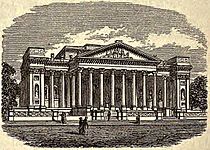Fitzwilliam Museum, Cambridge

The main entrance to the Fitzwilliam Museum, facing Trumpington Street.
|
|
| Established | 1816 |
|---|---|
| Location | Cambridge, United Kingdom |
| Coordinates | 52°12′01″N 0°07′10″E / 52.200278°N 0.119444°E |
| Type | University Museum of fine art and antiquities |
| Collection size | approx. 550,000 |
| Visitors |
470,000 (2011–12) |
| Director | Tim Knox |
 |
|
|
|
470,000 (2011–12)
The Fitzwilliam Museum is the art and antiquities museum of the University of Cambridge, located on Trumpington Street opposite Fitzwilliam Street in central Cambridge, England. It receives around 470,000 visitors annually (2011–12). Admission is free.
The Museum is the lead museum for the University of Cambridge Museums consortium, one of 16 Major Partner Museum services funded by Arts Council England to lead the development of the museums sector. The current Director of the Fitzwilliam Museum is Tim Knox.
The museum was founded in 1816 with the legacy of the library and art collection of the 7th Viscount FitzWilliam. The bequest also included £100,000 "to cause to be erected a good substantial museum repository". The collection was initially placed in the old Perse School building in Free School Lane. It was moved in 1842 to the Old Schools (at that time the University Library). The "Founder's Building" itself was designed by George Basevi, completed by C. R. Cockerell and opened in 1848; the entrance hall is by Edward Middleton Barry and was completed in 1875. The first stone of the new building was laid by Gilbert Ainslie in 1837. A further large bequest was made to the University in 1912 by Charles Brinsley Marlay, including a sum of £80,000 and a collection of 84 pictures. A two-storey extension, paid for partly by the Courtauld family, was added in 1931.
The museum has five departments: Antiquities; Applied Arts; Coins and Medals; Manuscripts and Printed Books; and Paintings, Drawings and Prints. Together these cover antiquities from ancient Egypt, Nubia, Greece and Rome, Romano-Egyptian art, Western Asiatic displays, and a new gallery of Cypriot art; applied arts, including English and European pottery and glass, furniture, clocks, fans, armour, Chinese, Japanese and Korean art, rugs and samplers; coins and medals; illuminated, literary and music manuscripts and rare printed books; paintings, including masterpieces by Simone Martini, Domenico Veneziano, Titian, Veronese, Rubens, Van Dyck, van Goyen, Frans Hals, Canaletto, Hogarth, Gainsborough, Constable, Monet, Degas, Renoir, Cézanne and Picasso and a fine collection of 20th-century art; miniatures, drawings, watercolours and prints. Among the most notable works in the collection are the bas-reliefs from Persepolis.
...
Wikipedia

